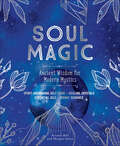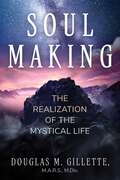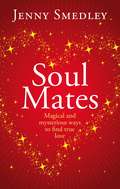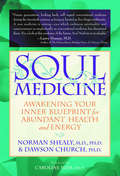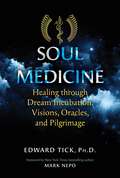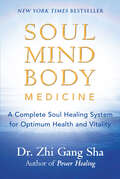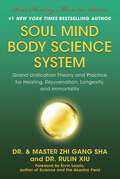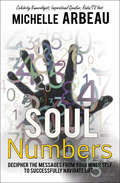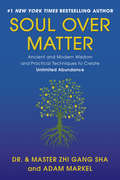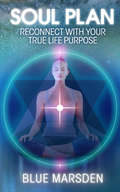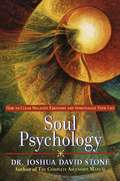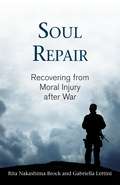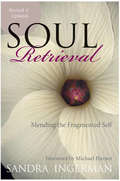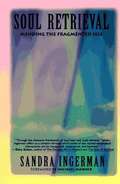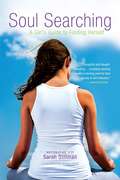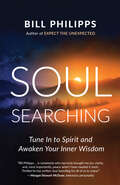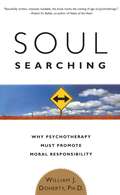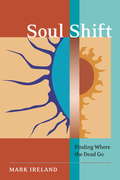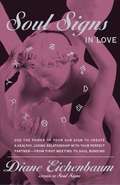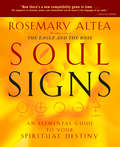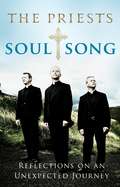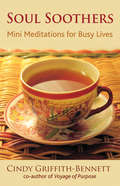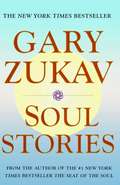- Table View
- List View
Soul Magic: Ancient Wisdom for Modern Mystics
by Arizona Bell Morgan GarzaCenturies of spiritual practice and self-care at your fingertips If you have ever hungered for a more meaningful or satisfying life journey, this comprehensive collection of all things spirit-nourishing is your soul’s true companion. Soul Magic is a treasure trove of centuries-old secrets and ancient wisdom to enrich your life, guide your choices, and heal your mind, body, and soul. Whether it’s aligning your career moves with the phases of the moon, dropping the baggage you’re carrying from a past life, programming a crystal to find love, or designating a meditation spot in your home, you’ll find plenty of empowering and pragmatic “now age” uses for age-old traditions. Guided by beautiful imagery and clear explanations from real experts in alternative practices, you will discover how to: • maximize the life-changing power of crystals, herbs, and essential oils • unblock your seven chakras and bring harmony to your whole self • use tarot cards to heighten your awareness and steer you toward your best future • observe a full day of rest and reflection no matter how busy your life may be • progress beyond traditional thinking to find true peace and satisfaction Anyone with a soul that’s yearning for some magic will find solace and answers in this comprehensive field guide to the human spirit.
Soul Making: The Realization of the Mystical Life
by Douglas M. Gillette• Explains how to embrace the paradox of the spiritual path—that we are already reflections of the Divine—and manifest our soul&’s transcendent nature in everyday life• Provides contemplative and philosophical tools to support the journey to experience the Sacred• Explores mythic stories of soul development and intuition found in Maya and Pythagorean traditions, ancient Egyptian thought, and ZoroastrianismIn the mind of the Divine, every person has Infinite, Eternal, and Absolute Worth. But how do we manifest our transcendent nature in everyday life? How can we construct our lives in the material world so they reflect the Divine nature of our souls?Through his own story of spiritual self-realization, Douglas M. Gillette explores the paradox that lies at the heart of the quest for union with the Divine. As the author explains, those of us on the mystical path are each working on our souls to better reflect their Divine nature, yet we are already reflections of the Divine. To help you embrace this paradox, the author provides mythic stories of soul development and intuition from Maya and Pythagorean traditions, ancient Egyptian thought, and Zoroastrianism. He shows how embracing the power of emotions like wonder, dread, and awe provide a mirror that allows us to see ourselves as infinite and immortal persons on finite and mortal adventures. In addition to myth, the author&’s synthesis of Neoplatonism and Panentheism provides readers with contemplative tools to fulfill their mystical journey.Bringing together a wide range of contrasting worldviews and ideas assumed to be in opposition, the author shows how unifying views that are often considered polar opposites is a primary vehicle for actualizing our core purpose as souls in the physical world. He deeply investigates the emergence of personhood as we build our material lives, and he reveals the thrill of actually entering into the Sacred through the paradoxical journey of soul making—becoming in the physical world what we already are in the infinity and eternity of the Divine Psyche.
Soul Mates: Magical and mysterious ways to find true love
by Jenny SmedleyIn her work as an international columnist and psychic advisor, the most common question Jenny Smedley is asked is: How can I find my soul mate? Now, for the first time, she will unravel the mysteries behind this most sought after state - that of being in love with the right person and making it last - and explore what magical and mystical means there are to help nature along, including colour, aura, spells, astrology, numerology and asking your angels to help. Providing practical, accessible advice on all soul mate situations, Soul Mates will show the reader not only how to find their soul mate, but also offer practical advice on maintaining the most important relationships in our lives.
Soul Mates: Magical and mysterious ways to find true love
by Jenny SmedleyBestselling author and columnist Jenny Smedley reveals the secrets to finding your soul mateHave you ever wondered who your soul mate is and how to find them, or whether you have one at all?The answers to these questions are much more complex than you think. In Soul Mates, international columnist and psychic advisor Jenny Smedley will unravel the mysteries behind this most sought-after state - that of being in love with the right person and making it last - to help you avoid any potential pitfalls in your quest to find your soul mate.Providing practical, accessible advice on all soul-mate situations, Soul Mates will help you to:- Differentiate between the various types of soul mates you might encounter and help you to understand why they are in your life- Recognise the signs that will lead you to your soul mate- Attract soul mates into your life using the power of auras, spells, numerology, crystals and astrology- Mend your heart if you've already had it broken so that you can get going on your journey to real love
Soul Medicine: Awakening Your Inner Blueprint For Abundant Health And Energy
by Dawson ChurchThe cutting edge of medicine today is not to be found in invasive therapies like drugs and surgeries. It is in the disciplines that used to be regarded as "soft" medicine: prayer, intention, energy healing, acupressure, and similar therapies. Overwhelming evidence from hundreds of scientific studies are showing that these safe, non-invasive approaches are often more effective, sometimes many times more effective, than conventional medicine.Two of the pioneers in the field, Dr. Norman Shealy, founder of the American Holistic Medical Association and world-famous neurosurgeon, and Dr. Dawson Church, one of the foremost writers and researchers in vibrational healing, and the editor or author of many books on the subject, explain the fundamentals of energy medicine, its many applications to common ailments, and the latest scientific research.
Soul Medicine: Healing through Dream Incubation, Visions, Oracles, and Pilgrimage
by Edward TickAn in-depth look at ancient Greek practices for profound, lasting healing• Explores hidden soul-healing practices including dream incubation and interpretation as well as sacred pilgrimage• Examines how dreams, visions, and other non-normative events reveal the conditions needed to restore the soul and facilitate healing• Includes successful healing techniques, practices, and case studies to reveal how healings are achieved with these methodsThe modern practice of medicine and psychology grew out of the ancient Greek healing tradition, said to be founded by Asklepios, god of healing and dreams. For two thousand years the system spread all over the Mediterranean world and planted the roots of Western medicine and psychology by offering ritual and holistic practices that recognized that healing begins at the soul level. Yet, since that time, the spiritually based practices were cast aside, leaving behind only the scientific medical techniques that dominate health care today. Resurrecting and restoring the sacred, mythological, and cultural origins of medicine and psychotherapy, Edward Tick, Ph.D., explores the soul-healing practices missing in our contemporary health systems. He looks at the dream incubation tradition of Asklepios, sacred theater of Dionysos, oracle gifting of Apollo, special practices of warriors, and their roots in Neolithic shamanism and indigenous traditions. Demonstrating the ritual use of dreams, visions, oracles, synchronicities, and pilgrimage for healing and connecting to the transpersonal and divine, he explains how dream incubation is a technique in which you plant a seed for a specific healing or growth goal.Using both ancient wisdom and modern depth psychology alongside stories of healings from his more than 25 years of guiding Vietnam veterans on Greek pilgrimages, Tick explores how we all can use ancient healing philosophies and practices to achieve holistic healing today. He examines the interaction between mind and body (psyche and soma) and between physical illness and the soul to heal PTSD and trauma. He explains the art of making accurate and holistic interpretations of signs, symbols, and symptoms to determine what they reveal about the soul. Showing how dreams and other transpersonal experiences are essential components of soul medicine, the author reveals how restoration of the soul facilitates true healing.
Soul Mind Body Medicine: A Complete Soul Healing System for Optimum Health and Vitality
by Zhi Gang ShaDiscover Dr. Sha's Powerful Techniques for Healing Your Soul, Mind, and Body What is the real secret to healing? Internationally acclaimed healer and author Dr. Zhi Gang Sha gives us a simple yet powerful answer to this age-old question: Heal the soul first; then healing of the mind and body will follow. In Soul Mind Body Medicine, Dr. Sha shows that love and forgiveness are the golden keys to soul healing. From that foundation, he presents practical tools to heal and transform soul, mind, and body. The techniques and the underlying theories are easy to learn and practice but profoundly effective. They include: Healing methods for more than 100 ailments, from the common cold to back pain to heart disease to diabetes Step-by-step approaches to weight loss, cancer recovery, emotional balance, and maintenance of good health A revolutionary one-minute healing technique Endorsements “Just as our thoughts can influence water, our souls can bring healing and balance to our selves, our loved ones, and our world today. Dr. Sha is an important teacher and a wonderful healer with a valuable message about the power of the soul to influence and transform all life. His book Soul Mind Body Medicine will deeply touch you.” — Dr. Masaru Emoto, author of The Hidden Messages in Water “All cultures have produced authentic healers from time to time. Dr. Zhi Gang Sha is such a healer — a man of deep wisdom and compassion, and a gift to the human race.” — Larry Dossey, MD, author of The Extraordinary Healing Power of Ordinary Things
Soul Mind Body Science System: Grand Unification Theory and Practice for Healing, Rejuvenation, Longevity, and Immortality
by Zhi Gang ShaWhat is a soul? Are miracles real? When the soul is healed, how does the body respond? Throughout history, there have been countless cases of "miracle" healings, unexplainable by modern science. Dr. and Master Zhi Gang Sha has personally healed thousands of patients, usually in front of dozens of witnesses. Hundreds of videos of these healings can be seen on YouTube. But how can these healings be explained? Soul Mind Body Science System is the first book to explore the scientific explanations for why soul healing miracles are genuine. Written with Dr. Rulin Xiu, an expert on string theory and quantum physics who trained at The University of California, Berkeley, Dr. Sha shares, for the first time, the scientific theories that explain why all actions on Earth are guided by the reality of the soul. In Soul Mind Body Science System, the complex and fascinating relationships present between matter, density, information, soul, and consciousness are thoroughly examined. Written for armchair and professional scientists alike, this book makes a significant contribution to the ongoing debate about the true nature of reality. As the lines between "science" and "spirit" blur, this investigation becomes ever more important. The groundbreaking Soul Mind Body Science System is for all readers who have contemplated the fundamental scientific laws of the universe and sought answers beyond those offered by popular science and mainstream faith.
Soul Numbers: Decipher the Messages from Your Inner Self to Successfully Navigate Life
by Michelle ArbeauIs it just a coincidence that a record number of people are seeing in numbers, or could it be the fabric of the universe revealing itself to us? According to the religion of Kabbalah and even the ancient Greek philosopher and mathematician Pythagoras, the truths of the universe are contained within numbers. The phenomena of numbers—seeing repeating numbers and number sequences—are sweeping the globe. People from the average Joe to celebrities are seeing repeating numbers on clocks, in addresses, in phone numbers, in account numbers, and on license plates, just to name a few. Repeating numbers and number sequences are showing up in both the quirky and the commonplace on a daily basis. Skeptics argue that seeing repeating numbers is simply a matter of pattern recognition and it&’s all in our head. There have been scientific theories throughout history that attempt to explain the basis of the universal structure—from String Theory to the Holographic universe. All things in existence can be counted, sorted, or measured using numbers and, intriguingly, a common thread in many theories is mathematics. More people are reporting the same phenomena in all cultures, races, and religions, turning skeptics into believers. Soul Numbers has the potential to create a tidal wave amid this numbers phenomenon, making it the new, most complete numbers-meaning bible. Numerology books offer some insight into the base number meanings of 0 to 9 but fail to go further to precisely pinpoint and explain why someone is seeing 1:47 on a clock daily and what it means to them. Covering the number meanings from 0 to 999, Soul Numbers helps readers decipher any number sequence. Whether they&’re seeing single 2s everywhere or exactly four—2222—it will allow them to break the numbers down like an ancient code. Unlike other titles with mainly angelic-focused number meanings, this book holds a broad spectrum view of number patterns, weaving science and spirituality to spark the curiosity of both the skeptic and the die-hard spiritualist.
Soul Over Matter: Ancient and Modern Wisdom and Practical Techniques to Create Unlimited Abundance
by Zhi Gang Sha William Gladstone Marilyn Tam Adam MarkelCombine Eastern and Western wisdom, mix in proven techniques from Adam Markel the CEO of New Peaks and proven techniques from legendary soul healer Dr. and Master Sha, and you get Soul Over Matter. Designed for readers at every level of economic experience, this book can increase their financial abundance. Soul Over Matter is destined to be the Think And Grow Rich of the 21st century. In addition to practical wisdom and easy-to-implement, proven techniques, the book includes specific financial blessing calligraphies, which allow readers to focus on their financial challenges and conquer them. There are universal laws for creating wealth, and Soul Over Matter explains these laws in simple language.Soul Over Matter is the first financial advice book to focus on the importance of soul in creating wealth. Other books such as Napoleon Hill's Think and Grow Rich have hinted at the importance of connecting to universal laws to create financial abundance. Soul Over Matter is the first book to give specific techniques to do so.
Soul Plan: Reconnect with Your True Life Purpose
by Blue MarsdenSoul Plan is a new interpretation of an ancient system of life purpose analysis. It introduces a totally unique and fascinating method of numerology based on sound and intention and allows the reader access to a free online Soul Plan checking website. Available for the first time to a wider audience, this truly empowering method accesses the sound vibration in your birth name to determine your entire 'Soul Plan' and life path.Using an easy-to-follow method you will: • uncover your greatest strengths (career, creative, financial and spiritual talents) and align with your higher Soul Purpose• understand the past and reveal your best future potential• see clearly your greatest challenges and how these can be overcome• receive an energetic activation and practical tools to heal and align your purpose• align with your higher Soul Purpose• enjoy working out your own Soul Plan and the Plans of others (or use a FREE online programme to instantly chart them).
Soul Psychology: How to Clear Negative Emotions and Spiritualize Your Life
by Joshua David StoneThe words of Sai Baba, "God equals man minus ego," are echoed by Dr. Joshua David Stone in his seminal work, Soul Psychology. A veteran transpersonal psychologist and family counselor, Dr. Stone teaches us how our entire understanding of ourselves and others is completely changed when we integrate our soul into the way we live our lives. Based on eighteen years of Dr. Stone's practice, this book is not a psychological approach to spirituality. It is rather a spiritual approach to the psychology of everyday living.At the heart of Soul Psychology is emotional healing through the dismantling of the "negative ego," a psychological cancer that prevents us from acting in accordance with our soul's true nature and purpose. This negative energy drives us to find our security outside of ourselves; whereas the only true security is one that is grounded in having a right relationship with self and a right relationship with the Divine. To guide us onto this path of spiritual ascension, Soul Psychology offers a stimulating new viewpoint that expands the boundaries of traditional spiritual practice, providing a wealth of accessible and powerful meditations and exercises, including- The six-step process for healing and spiritualizing emotions- The spiritual science of the seven rays and the twenty-two chakras- Methods for clearing negative psychic energies that inhibit soul growth- The one hundred most common pitfalls and traps on the spiritual pathFrom the Trade Paperback edition.
Soul Repair: Recovering from Moral Injury after War
by Rita Nakashima Brock Gabriella Lettini<p>The first book to explore the idea and effect of moral injury on veterans, their families, and their communities. <p>Although veterans make up only 7 percent of the U.S. population, they account for an alarming 20 percent of all suicides. And though treatment of post-traumatic stress disorder has undoubtedly alleviated suffering and allowed many service members returning from combat to transition to civilian life, the suicide rate for veterans under thirty has been increasing. <p>Research by Veterans Administration health professionals and veterans' own experiences now suggest an ancient but unaddressed wound of war may be a factor: moral injury. This deep-seated sense of transgression includes feelings of shame, grief, meaninglessness, and remorse from having violated core moral beliefs. <p>Rita Nakashima Brock and Gabriella Lettini, who both grew up in families deeply affected by war, have been working closely with vets on what moral injury looks like, how vets cope with it, and what can be done to heal the damage inflicted on soldiers' consciences. <p>In <i>Soul Repair</i>, the authors tell the stories of four veterans of wars from Vietnam to our current conflicts in Iraq and Afghanistan--Camillo "Mac" Bica, Herman Keizer Jr., Pamela Lightsey, and Camilo Mejía--who reveal their experiences of moral injury from war and how they have learned to live with it. Brock and Lettini also explore its effect on families and communities, and the community processes that have gradually helped soldiers with their moral injuries. <p><i>Soul Repair</i> will help veterans, their families, members of their communities, and clergy understand the impact of war on the consciences of healthy people, support the recovery of moral conscience in society, and restore veterans to civilian life. When a society sends people off to war, it must accept responsibility for returning them home to peace.</p>
Soul Retrieval
by Sandra IngermanWith warmth and compassion, Sandra Ingerman describes the dramatic results of combining soul retrieval with contemporary psychological concepts in this visionary work that revives the ancient shamanic tradition of soul retrieval for healing emotional and physical illness. This revised and updated edition includes a new afterword by the author.
Soul Retrieval: Mending the Fragmented Self
by Michael Harner Sandra IngermanWith warmth and compassion, Sandra Ingerman describes the dramatic results of combining soul retrieval with contemporary psychological concepts in this visionary work that revives the ancient shamanic tradition of soul retrieval for healing emotional and physical illness. This revised and updated edition includes a new afterword by the author.
Soul Searching: A Girl's Guide to Finding Herself
by Sarah StillmanGirl Power lives! Written when the author was sixteen and updated to address the concerns of today's teens, Soul Searching brings girl power to the printed page by offering young women a clear path to self-discovery and empowerment. Through fun quizzes, insightful exercises, and provocative statistics, Sarah Stillman guides young women through the complex maze between adolescence and adulthood. While fashion magazines, television programs, and websites emphasize the superficial and foster insecurities, Stillman directs teen girls to a healthy place where a strong sense of self and direction take center stage. With updated sections on safe cell-phone use, social media, cyber bullying, health, and gender, as well as updated resources throughout, Soul Searching is a must-read for teenage girls.
Soul Searching: A Girl's Guide to Finding Herself
by Sarah StillmanAn updated, indispensable guide to empowerment and self-discovery for teens.While fashion magazines, television programs, and websites emphasize the superficial and foster insecurities, Sarah Stillman directs teen girls to a healthy place where a strong sense of self and direction take center stage. Originally written when the author was just sixteen, Soul Searching has been fully updated and expanded to address the concerns of today's teens, bringing girl power to the printed page by offering young women a clear path to self-discovery and empowerment. Through fun quizzes, insightful exercises, and provocative statistics, Stillman guides young women through the complex maze between adolescence and adulthood. Featuring updated sections on safe cell-phone use, social media, health, and gender, as well as including updated resources throughout, Soul Searching is a must-read for teenage girls.
Soul Searching: Tune In to Spirit and Awaken Your Inner Wisdom
by Bill PhilippsRECONNECTING TO THE PUREST VERSION OF OURSELVES Reclaiming our destiny and moving forward requires finding our higher self — the innocent, virtuous, vulnerable child within us. Our spirit self is always in contact with that child, who wants us to be more imaginative, intuitive, honest, and open to receiving love, no matter what indoctrinations and toxic environments we have experienced. In Soul Searching, beloved psychic medium Bill Philipps shows how to reconnect to that spiritual nature we had as children and why those gifts we entered this life with are important. Using beautifully written stories and practical suggestions, Bill helps us access and build upon our innate skills of intuition, trust, forgiveness, and gratitude. He shows that it is not only possible but crucial to: • hear, feel, and honor our grief without being overwhelmed by it • forgive without forgetting • embrace and utilize the powers of gratitude, prayer, and setting intentions to manifest the life we desire • set ourselves and others fully free to live, love, and thrive
Soul Searching: Why Psychotherapy Must Promote Moral Responsibility
by William J. DohertyPaul, a divorced father, wants to back out of his child care arrangement and spend less time with his children. Nathan has been lying to his wife about a serious medical condition. Marsha, recently separated from her husband, cannot resist telling her children negative things about their father. What is the role of therapy in these situations? Trained to strive for neutrality and to focus strictly on the clients’ needs, most therapists generally consider moral issues such as fairness, truthfulness, and obligation beyond their domain. Now, an award-winning psychologist and family therapist criticizes psychotherapy’s overemphasis on individual self-interest and calls for a sense of moral responsibility in therapy.
Soul Shift
by Mark Ireland Tricia J. RobertsonBusinessman Mark Ireland's father was Richard Ireland, a deeply spiritual minister and renowned psychic and medium who counted Mae West among his famous clients. While he loved his father, Mark followed a more conventional path in pursuit of mainstream success--until the wrenching death of his youngest son. This unexpected tragedy plunges Mark into the spiritual world of psychics and mediums in a frantic attempt to communicate with the dead. His defenses and pragmatic mindset begin to fade as he remembers premonitions on the day of his son's death. He consults a number of well-known mediums and is struck by the remarkably accurate information their readings provide. Mark first meets with Allison Dubois, the subject of NBC's hit show Medium, and later participates in a single-blind lab experiment with medium Laurie Campbell, filmed for a Discovery Channel feature. He then enters a new dimension of personal paranormal experience, as his own psychic awareness begins to unfold. This dramatic story of a father's unbearable loss and his discovery of life after death offers hope to the bereaved and compelling evidence that death may not be the end.From the Trade Paperback edition.
Soul Signs in Love
by Diane EichenbaumDo you believe that the key to finding your soul mate is only in your stars? That you and your partner must have compatible Sun signs if romance is going to thrive? Not so! The truth is that many couples who seem ideally matched astrologically don't sustain a loving relationship. While most astrology books may tell you that true love is a matter of fate, Diane Eichenbaum's Soul Signs in Love shows you that you have the freedom to create the relationship that's right for you. Eichenbaum reveals that relationships involve a combination of factors: destiny, an understanding of each partner's sign, and the willingness to work through the highs and lows of love's natural progression. Each of the twelve signs of the Zodiac corresponds to a phase of a romance, from passionate court-ship, represented by fiery Aries, to the commitment and soul bonding of watery Pisces. Each Sun sign has its gifts (the discernment of Virgo or the enthusiasm of Sagittarius, for example) and its corresponding challenges (the self-doubt of Taurus or the unpredictability of Aquarius) that it brings to a relationship. By understanding that the choice to love and grow with your partner is yours and yours alone, Soul Signs in Love shows you how to enjoy and revel in the unfolding process of discovery and revelation that underlies lasting love.
Soul Signs: An Elemental Guide to Your Spiritual Destiny
by Rosemary AlteaIn Soul Signs, bestselling author, spiritual medium, and healer Rosemary Altea introduces a fascinating system of soul typing that reveals the dynamics of attraction.Which energy group do you belong to--the strategic and grounded earth signs, passive and charming air signs, compromising yet unstoppable water signs, the ever-changing emotional fire signs, or the destructive dark sign, sulfur? Are you a strong-willed, emotionally driven, perfectionist Retrospective soul? A vivacious, radiant, quick-witted Bright Star soul? A thrill-seeking, romantic but fickle Traveler soul? What about your mate? Once readers learn the science behind soul typing, they will enjoy "typing" their friends, family, and even celebrities to better understand why some people seem so happy, others at war with themselves, and--the most fun--who belongs together.
Soul Song: Reflections On An Unexpected Journey by The Priests
by David Delargy Eugene O'Hagan Martin O'HaganKnown collectively as The Priests, Fr Martin, Fr Eugene and Fr David, have taken the music world by storm. Since they signed their much-reported Sony contract in front of Westminster Cathedral in April 2008, their album has sold almost 2,000,000 copies worldwide and broke the Guinness record for the fastest-selling debut classical album in the UK. It has also chalked up an impressive fifteen weeks at No. 1 on the Classic FM chart and was nominated for a Classical Brit Award. In June 2009, The Priests topped off their incredibly successful year with a highly-acclaimed mini-tour of the UK and Ireland. But long lunches in swanky restaurants and celebrity parties count for little with these down-to-earth, wonderfully talented singers, because first and foremost, David, Martin and Eugene are priests; their faith and the work they undertake in their busy parishes takes priority over everything else they do. So, whilst their gruelling promotional schedule for the album has taken them around the world - from Europe to Montreal and Toronto, from Washington to New York and Sydney, where they have played to packed houses and given dozens of press, radio and tv interviews - they have always been happy to return to their parishes in Belfast and the people they serve. Now in Soul Song, The Priests draw upon their unique experiences as priests and performers, their love of music and their faith, as they weave together a rich, illuminating tapestry of spiritual wisdom. Insightful and engaging, it is a treasury of memories which offers us all a rare and timely opportunity to reflect on our own journey through life.
Soul Soothers
by Cindy Griffith-BennettFeaturing one-page meditations that can be practiced all day-while doing the dishes, waiting at the doctor's office, or even in the shower-this book is designed to calm those with busy lives. In addition to the easy-to-look up meditations for a myriad of circumstances, the book also includes information on the importance of meditation as well as spiritual topics such as energy, breathing, charkas, light work, vibrations, mindfulness, and intuitive listening. Whether for stress reduction or spiritual development, Soul Soothers brings peace to frenzied lives and provides the benefits of meditation without the burden of taking more time out of already overloaded schedules.
Soul Stories
by Gary ZukavTrue Stories That Transform Lives Writing with profound psychological and spiritual insight, prize-winning author Gary Zukav has had a major impact on the consciousness of millions. In his New York Times number-one bestseller, The Seat of the Soul, he explained how the expansion of human perception beyond the five senses leads to a new understanding of power -- the alignment of the personality with the soul -- which in turn leads to an awareness of our extraordinary creative abilities. Now, in one of the most important and useful books you will ever read, Soul Stories, Zukav shows how this new understanding of power -- authentic power -- transforms lives in countless ways. Soul Stories is filled with marvelous stories that show how concepts such as intuition, harmony, cooperation, sharing, and reverence for life actually express themselves in people's lives. Best of all, the stories lead to practical advice on how you can discover your own Soul Stories and the truths they reveal about the deepest sources of your being. Wonderfully readable, Soul Stories is a wise and inspirational book.
